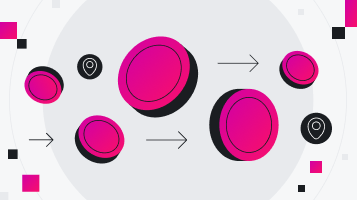Addicted to BaaS: Why embedded finance will make your product stickier

Today’s customer is fickle. Even if your business excels in its niche, with alternative options just a tap away, there’s always a threat that customers will migrate the moment your competitors come up with a slicker solution.
According to the Harvard Business Review, increasing customer retention by just 5% can result in profits rising by 25 to 95%. With this in mind, the question that today’s SaaS businesses need to ask themselves is: how do I make my product stickier?
In this article, we’ll explore how embedding financial services into your product can keep customers loyal to your business. Research shows that the average person is more likely to break up with their spouse than with their bank. Can SaaS businesses achieve that level of loyalty by becoming a de facto bank for their customers?
Keeping third-party vendors loyal
Finance is a sticky industry by nature. Once a user trusts you with their money, they are more likely to remain with you.
Most businesses handle financial transactions in some way, but in recent years several companies have gone beyond simple payment processing to offer their clients a suite of financial services.
Uber was an early adopter, they started offering drivers an Uber debit card back in 2016. By issuing their own debit cards, Uber allowed drivers to earn and spend revenue within the app, without ever moving money to a bank. Drivers also benefitted from additional perks such as cashback on fuel and other purchases. In essence, Uber now helps drivers manage their money, not just earn it.
For Uber, attracting and retaining drivers is a priority. The more drivers they have, the better the service they’re able to offer their customers. The same can be said for eCommerce marketplaces such as Amazon, which need to attract and retain third party merchants in order to maintain their position as the go-to option for a wide range of consumer goods. By embedding financial products into their platform, these businesses have an opportunity to keep third party vendors loyal. Once a vendor has started using your platform as their de facto bank account, they’re more likely to stick with you. That’s the idea, anyway.
Staying ahead of the competition
Rideshare apps and eCommerce marketplaces aren’t the only businesses taking advantage of emerging financial technology. WealthTech apps, payments platforms and lenders are also getting in on the act.
For these businesses, embedded finance can speed up product development, helping them launch new features in record time, and keeping them one step ahead of the competition.
In 2022, the wealth management app Plum launched an investment feature which allows users to trade in a variety of global stocks. They chose to embed Airwallex’s Transactional FX solution into their platform in order to offer the best FX rate to customers who want to trade internationally. Choosing to buy rather than build this feature meant Plum was able to go to market fast. Which, in the competitive WealthTech space, is crucial to customer retention.
Meanwhile, alternative lenders like TradeBridge use embedded finance to programmatically deliver funds to clients across global markets and create a better experience for their customers. In the words of TradeBridge CEO Mark Coxhead: “Companies like Airwallex give online businesses the chance to be global players in a way that would have been too difficult before.”
Creating a closed loop
A crucial benefit of embedding financial products into your platform is that you can create a closed loop customer experience. In other words, all relevant financial transactions made by your customer (whether that’s receiving funds, converting currencies or spending) can occur within the boundaries of your platform.
Creating a closed loop means your customers no longer need to rely on third party financial institutions, such as banks, in order to manage their money. Instead, they can manage their money on your platform. Not only will this make your product stickier, it also gives you an opportunity to better serve your customers.
A lender, for example, can create their own client bank accounts in which to deposit funds. They can then track how much their client has spent and repaid, then programmatically offer additional funds when those accounts run low. This level of visibility used to be the privilege of banks and credit card companies. Now, all kinds of businesses can offer their clients this service.

How does embedded finance work in practice?
Thanks to the presence of specialised fintechs, integrating financial services into your business is simply a matter of finding the right partner. This partner will have all the necessary infrastructure in place, including banking licences and payment network partnerships, KYC and compliance frameworks, and APIs that allow for quick integration and minimal development effort on your part.
All you need to do is decide which services you’d like to offer your customers. Whether that’s issuing your own branded debit cards or offering them the best FX rates on the market. Once you know what you want, you need to find the fintech partner that’s right for you.
Let’s chat!
Airwallex offers a wide range of embedded finance solutions that can be tailored to fit the specific needs of your business — from transactional FX, to Global Accounts and Card issuing. Our 50+ global banking licences, flexible APIs and world-class team of developers will allow you to launch new financial products across regions fast. We also take care of KYC and compliance, so you can concentrate on launching your new product.
If you’d like to learn more about Airwallex’s embedded finance options, get in touch today.
Share

Tilly manages the content strategy for Airwallex. She specialises in content that supports businesses in their growth trajectory.
View this article in another region:AustraliaUnited KingdomGlobal
Related Posts

How to use Airwallex for automated insurance payouts
•5 minutes

Wallets, cards, and the flywheel effect: the formula for marketpl...
•6 minutes
